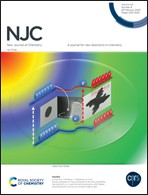Biochars obtained from arabica coffee husks by a pyrolysis process: characterization and application in Fe(ii) removal in aqueous systems†
Abstract
In this work biochars were synthesized from arabica coffee husks and were used for Fe(II) adsorption by a pyrolysis process at 350 and 600 °C. The in natura material before and after pyrolysis exhibited an amorphous structure, showing C, H, and N levels, for both biochars, of around 70, 0.25, and 2.5% (m/m), respectively. The Point of Zero Charge (PZC) was 9.5 and 10.2 for BIO350 and BIO600, respectively. FTIR spectra and thermogravimetric analyses confirmed the presence of OH, COOH, and SO3H groups on the coffee husks’ surfaces as well as the loss of these groups on the biochars’ surfaces, with the biochars being more stable than the coffee husks. The synthesized biochars presented amorphous characteristics before the adsorption process of iron(II), but turned into nail-like structures after the Fe(II) adsorption studies. The Langmuir isotherm model and pseudo-second order kinetic model were the best models fitted to the experimental data and were evaluated based on the coefficient of determination. Both biochars demonstrated similar efficiencies in Fe(II) removal, with a maximum adsorption capacity of about 110 mg of Fe(II) per gram of biochar. The adsorption thermodynamics indicates a spontaneous and favorable process, thus justifying the use of biochars for Fe(II) adsorption in aqueous solution.



 Please wait while we load your content...
Please wait while we load your content...